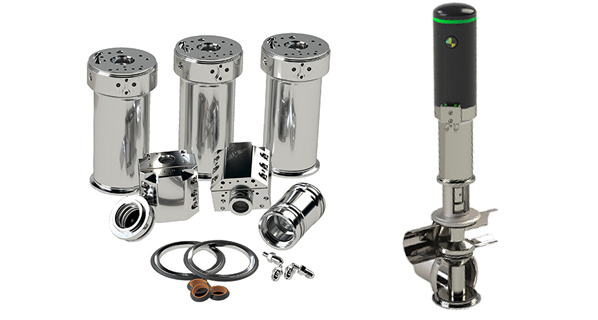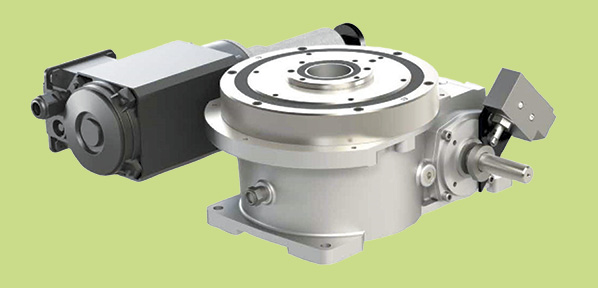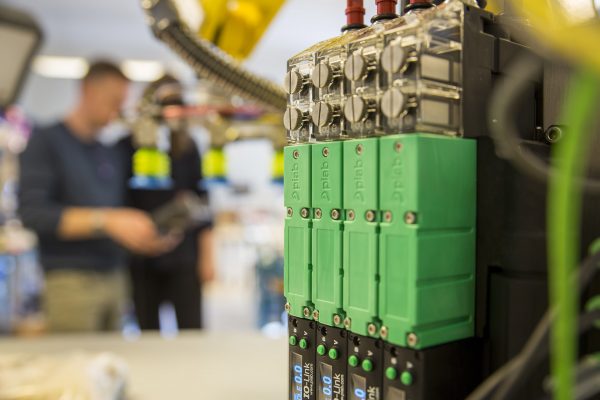Strategic Vacuum Cup Economics

By Dane Spivak, Davasol
The following is an opinion article written by Dane Spivak of Davasol Incorporated, an industrial brand management firm with many clients. This article is written in partnerhsip with one client, Vacuforce LLC, based in Indianapolis, Indiana, USA. The example numbers enclosed have been arbitrarily chosen and do not reflect a real-life company financial situation. If you have any questions, contact Dane Spivak at dspivak@davasol.com.
Introduction
It is widely accepted and understood that vacuum cups are a consumable product by nature. A vacuum cup may last many months or only a day or two. Although vacuum cups in general are not often seen as a substantial corporate expense, they can possibly incur a larger cost than one would expect. This article discusses the significance of vacuum cup selection and how it ties into the overall cost within a business. We will also touch on how to select an appropriate vacuum cup model based on economic and production needs.
Controversial Cup Selection
Depending on the product surface to be gripped or lifted, there are many different vacuum cups that can provide a good seal. If we consider a piece of glass, for example, there are thousands of cup models that can seal against its flat smooth surface. Alternatively, creating a cup seal on a bag proves to be more challenging and limits available choice. However, there are still many models that can do the job. So how do we choose the ideal cup?
More often than not, machine builders or vacuum cup users select a particular cup simply because it was readily available in stock. The easy choice is to use a familiar model that is on hand, and as long as it provides a decent seal, all is well. So generally speaking, not much thought is put into this process. Then, the cup is implemented into the production line, but its durability might become a liability. Since vacuum cups may need replacement—some as often as every day—using a long-lasting cup can be crucial, especially if you are a high-volume user. The following offers recommendations in strategy for identifying the best cups for the application.
Building Blocks to Increase Cup Life
Vacuum cups come in all shapes, sizes, and materials. These features play an important role in the performance and longevity of the cups. Let’s start by analyzing the cup style. Figure 1 shows three styles including flat, single bellows, and multiple bellows. Intuition tells us the flat cup provides a sturdier and more secure grip on the product whereas the multiple bellows cup is not as stable. The bellows creates more stress on the cup body and lip. This concept suggests that a cup with more bellows is typically not as durable. So to increase cup life, flat cups are ideal, or if possible, reduce the number of bellows.
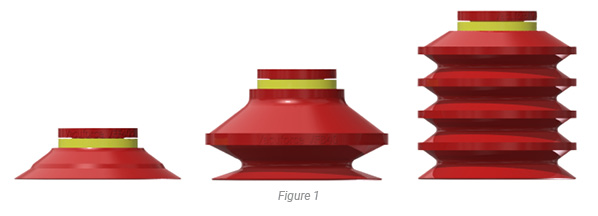
The cup lip thickness affects its life too – refer to Figure 2. Since this is the point of contact with the product, it is certainly a critical factor. For the most part, thicker cup lips last longer. A vacuum cup will have its lip wear away until it can no longer provide a satisfactory seal. At that point, the cup needs to be changed. Lower quality cups can crack at the lip or bellows. This is an indication that the cup is not being used to its full potential as it is prematurely breaking instead of wearing away. This is often referred to as work hardening.
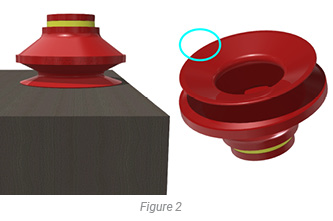 Material selection is arguably the primary characteristic in determining cup durability. Various cup materials are used, but the most commonly supplied are foam, vinyl, silicone, NBR, and polyurethane. This is in respective order of average cup life from shortest to longest; foam being the quickest to wear and polyurethane, arguably, the most durable. The cup features influence each material, though considering like-for-like models this rule of thumb applies. The product being gripped can also “fight back” against the cup material and cause it to wear quicker. For example, chemicals or high/low temperatures can reduce the cup life of NBR or polyurethane, and so silicone may offer longer life instead since it has a high chemical resistance and temperature range.
Material selection is arguably the primary characteristic in determining cup durability. Various cup materials are used, but the most commonly supplied are foam, vinyl, silicone, NBR, and polyurethane. This is in respective order of average cup life from shortest to longest; foam being the quickest to wear and polyurethane, arguably, the most durable. The cup features influence each material, though considering like-for-like models this rule of thumb applies. The product being gripped can also “fight back” against the cup material and cause it to wear quicker. For example, chemicals or high/low temperatures can reduce the cup life of NBR or polyurethane, and so silicone may offer longer life instead since it has a high chemical resistance and temperature range.
The quality of material can have a tremendous influence on cup durability. Numerous suppliers manufacture the most common industry models, however, each offers different life expectancies. This is due to the quality of material, manufacturing techniques, and mold conditions.
A quick note about color. The color of a vacuum cup does not affect its life as it is simply a dye used in the manufacturing process. This is often misunderstood as specific materials tend to be linked to their common dye color.
Cost vs Durability Paradox
Everyone likes a good deal to save money. Each purchasing decision is an investment and the price tag is usually front and center. However, our obsession with getting the best deal can often cloud the big picture results. Vacuum cups, being a wearable item, gives us a new perspective and approach to its investment. Table 1 compares three different cups and their yearly financial impact.
Cup1 = $6.00 x 1200 = $7,200
Cup2 = $10.00 x 400 = $4,000
Cup3 = $18.00 x 300 = $5,400
Table 1 suggests that Cup2 is the best investment. Although it costs more than Cup1, it lasts longer so the overall yearly cost is lower. Cup3 offers better durability, but its increased life expectancy does not outweigh the overall yearly cost compared to Cup2. So in this closed parameter analysis, we can crown Cup2 as the winner. However, there are other effects on vacuum cups that can come into play.

Downtime Impact
All manufacturing sectors experience downtime or scheduled maintenance, and everyone has the same interest: minimize the occurrences and time frames. Depending on the industry and manufacturing process, the impact can be drastically different. A large company that runs a three shift, 24-hour operation, with each process relying on one another for productivity, would value downtime much more.
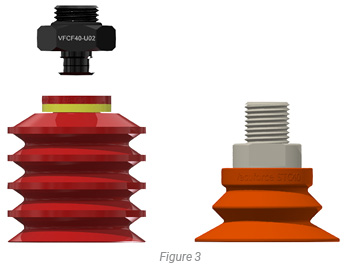 Let’s first consider how to reduce downtime when physically replacing a vacuum cup. One key feature can make a significant difference. Figure 3 shows two types of vacuum cups. One with a loose fitting and the other with the cup molded to the fitting. The loose model offers a distinct advantage for replacing cups as it can be pulled off the fitting, then have a new one pushed back on—an easy, quick interchange. However, the molded cup assembly fitting needs to be unscrewed, and of course, the new cups need to be threaded in and tightened with a tool: a lengthier process by comparison, which can be quite time consuming when replacing multiple cups on a few tools. Pull-off-and-push-on cup assembly fittings are ideal for ease of maintenance and should be used if possible. However, molded cup assembly fittings are sometimes all that is available particularly for larger vacuum cups.
Let’s first consider how to reduce downtime when physically replacing a vacuum cup. One key feature can make a significant difference. Figure 3 shows two types of vacuum cups. One with a loose fitting and the other with the cup molded to the fitting. The loose model offers a distinct advantage for replacing cups as it can be pulled off the fitting, then have a new one pushed back on—an easy, quick interchange. However, the molded cup assembly fitting needs to be unscrewed, and of course, the new cups need to be threaded in and tightened with a tool: a lengthier process by comparison, which can be quite time consuming when replacing multiple cups on a few tools. Pull-off-and-push-on cup assembly fittings are ideal for ease of maintenance and should be used if possible. However, molded cup assembly fittings are sometimes all that is available particularly for larger vacuum cups.
There are many contributing factors, but the primary costs of downtime include production loss, labor costs, and time. Table 2 uses the same data from Table 1 to compare the three cup models. In this example, we will consider all cup models to have equal time needed for interchange, and therefore the frequency of changing out the cups determines downtime cost.
Production Loss = $1,300 per hour
Labor Cost = $200 per hour
Interchange Time = 1 hour
Downtime Cost = ($1,300 + $200) x 1 = $1,500 per interchange
Yearly Downtime Cup1 = $1,500 x 12 = $18,000
Yearly Downtime Cup2 = $1,500 x 4 = $6,000
Yearly Downtime Cup3 = $1,500 x 3 = $4,000
Contrary to Table 1, Table 2 suggests that Cup3 is the better financial choice. Not only that, but less frequent cup changeouts create peace of mind. The human and reliability aspects can incur their own set of costs.

The Liability of Reliability
Reliability of a vacuum cup is arguably the most important feature. We discussed cup life, which over time can be very predictable, but what about instances when cups fail unexpectedly? It’s a rare occurrence, but cups can fail due to external influenced damage, cracking, falling off its fitting, and other situational anomalies. In turn, it can result in damaged product, broken machines, and even worse, injured workers. These are considered “what-if” scenarios and are generally immeasurable, but should not be overlooked.
For the most part, cups with higher durability are usually more reliable. But it is important to choose a cup that offers a confident seal, and ensure the machine is adjusted and designed to work effectively with the chosen cup. Table 3 includes a reliability cost associated with the points discussed above and demonstrates additional cost savings with Cup3. It also provides an understanding of the potential large gap in overall costs between Cup1 and Cup3.
It is difficult to designate a specific dollar value to reliability cost as it is unpredictable and can incur larger values from a single incident. Our theory is that cups with shorter life pose greater liability and therefore will result in higher costs. The following example is a hypothetical situation for each cup model based on a five-year period.
Yearly Reliability Cost = (Total Production Loss + Total Machine Repairs)/Time
Time = 5 years
Cup1 Total Production Loss = $48,000
Cup1 Total Machine Repair = $12,000
Cup1 Yearly Reliability Cost = ($48,000 + $12,000) / 5 = $12,000 per year average
Cup2 Total Production Loss = $16,000
Cup2 Total Machine Repair = $4,000
Cup2 Yearly Reliability Cost = ($16,000 + $4,000) / 5 = $4,000 per year average
Cup3 Total Production Loss = $12,000
Cup3 Total Machine Repair = $3,000
Cup3 Yearly Reliability Cost = ($12,000 + $4,000) / 5 = $3,000 per year average

Conclusion
This article covered strategies to increase vacuum cup durability and how to interpret long-term cup costs. With this analysis we have found that cup model selection and price can have a greater effect on the financial impact than one would expect. Although this is a subjective recommendation, it is based on actual experiences in a production environment. To ensure you choose the right cup for your application, a professional evaluation is recommended.

